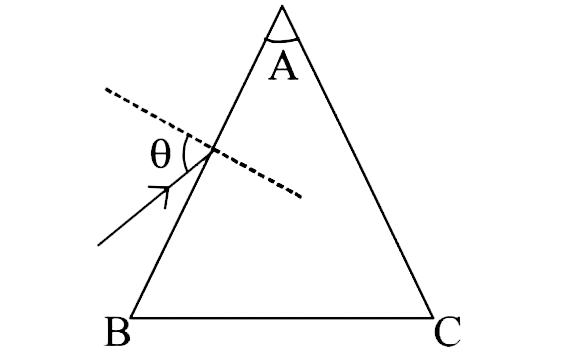Refractive index of a prism is √73 and the angle of prism is 60∘. The limiting angle of incidence of a ray that will be transmitted through the prism is approximately
π3
π6
2π3
π2
The correct Answer is:B
To find the limiting angle of incidence for a ray that will be transmitted through a prism with a refractive index of √73 and an angle of prism of 60∘, we can follow these steps:
Step 1: Understand the Geometry of the Prism
The angle of the prism is given as A=60∘. When light enters the prism, it refracts at the first surface and again at the second surface. Let r1 be the angle of refraction at the first surface, and r2 be the angle of refraction at the second surface. According to the prism's geometry, we have:
r1+r2=A=60∘
Step 2: Apply Snell's Law at the First Surface
Using Snell's Law at the first surface, we have:
sini=μsinr1
where i is the angle of incidence and μ is the refractive index of the prism, given as μ=√73.
Step 3: Express r1 in Terms of r2
From the geometry of the prism, we can express r1 as:
r1=60∘−r2
Substituting this into Snell's Law gives us:
sini=μsin(60∘−r2)
Step 4: Consider the Critical Angle
For total internal reflection to occur at the second surface, r2 must be less than or equal to the critical angle θc. The critical angle can be calculated using:
sinθc=1μ
Calculating θc:
sinθc=1√73=√37
Thus, the critical angle θc can be found using:
θc≈arcsin(√37)≈40.9∘
Step 5: Set r2 to Its Maximum Value
To find the limiting angle of incidence, we set r2 to its maximum value, which is equal to the critical angle:
r2=θc≈40.9∘
Step 6: Substitute r2 Back into the Equation
Now substitute r2 back into the equation for r1:
r1=60∘−40.9∘=19.1∘
Now, substitute r1 into Snell's Law:
sini=μsin(19.1∘)
Step 7: Calculate sini
Substituting the value of μ:
sini=√73sin(19.1∘)
Calculating sin(19.1∘):
sin(19.1∘)≈0.327
Thus,
sini≈√73⋅0.327≈0.5
Step 8: Find the Minimum Angle of Incidence
Finally, we find the angle of incidence i:
i=arcsin(0.5)=30∘
Final Answer
The limiting angle of incidence of a ray that will be transmitted through the prism is approximately 30∘.
---
The angle of the prism is given as A=60∘. When light enters the prism, it refracts at the first surface and again at the second surface. Let r1 be the angle of refraction at the first surface, and r2 be the angle of refraction at the second surface. According to the prism's geometry, we have:
r1+r2=A=60∘
Using Snell's Law at the first surface, we have:
sini=μsinr1
where i is the angle of incidence and μ is the refractive index of the prism, given as μ=√73.
From the geometry of the prism, we can express r1 as:
r1=60∘−r2
Substituting this into Snell's Law gives us:
sini=μsin(60∘−r2)
For total internal reflection to occur at the second surface, r2 must be less than or equal to the critical angle θc. The critical angle can be calculated using:
sinθc=1μ
Calculating θc:
sinθc=1√73=√37
Thus, the critical angle θc can be found using:
θc≈arcsin(√37)≈40.9∘
To find the limiting angle of incidence, we set r2 to its maximum value, which is equal to the critical angle:
r2=θc≈40.9∘
Now substitute r2 back into the equation for r1:
r1=60∘−40.9∘=19.1∘
Now, substitute r1 into Snell's Law:
sini=μsin(19.1∘)
Substituting the value of μ:
sini=√73sin(19.1∘)
Calculating sin(19.1∘):
sin(19.1∘)≈0.327
Thus,
sini≈√73⋅0.327≈0.5
Finally, we find the angle of incidence i:
i=arcsin(0.5)=30∘
The limiting angle of incidence of a ray that will be transmitted through the prism is approximately 30∘.
Topper's Solved these Questions
- RAY OPTICSBook:DC PANDEY ENGLISHChapter:RAY OPTICSExercise:medical entrance special format question
Explore 23 Videos
- NUCLEIBook:DC PANDEY ENGLISHChapter:NUCLEIExercise:C MADICAL ENTRANCES GALLERY
Explore 46 Videos
- REFLECTION OF LIGHTBook:DC PANDEY ENGLISHChapter:REFLECTION OF LIGHTExercise:Subjective
Explore 9 Videos
Similar Questions
Refractive index of a prism is √7/3 and the angle of prism is 60∘. The minimum angle of incidence of a ray that will be transmitted through the prism is
View SolutionFor a prism kept in air, it is found that for an angle of incidence 60∘ , the angle of refraction 'A', angle of deviation δ, and angle of emergence 'e' become equal. The minimum angle of incidence of a ray that will be transmitted through the prism is
View SolutionProve that the limiting angle of incidence of a ray that can be transmitted by an equilateral prism of μ=√7/3 will be 30∘.
View SolutionThe refractive index of a prism is μ. Find the maximum angle of the prism for which a ray incident on it will be transmitted through other face without total internal reflection.
View SolutionIf the refracting angle of a prism is 60∘ and the minimum deviation is 30∘, then the angle of incidence is
View SolutionThe refractive index of the material of prism √3, then the angle of minimum deviation of prism is
View SolutionMonochromatic light is incident on a glass prism of angle A. If the refractive index of the material of the prism is μ, a ray, incident at an angle θ, on the face AB would get transmitted through the face AC of the prism provided:

View SolutionThe angle of a prism is 60∘ and its refractive index is √2. The angle of minumum deviation sufferred by a ray of light in passing through it is
View SolutionThe angle of minimum deviation measured with a prism is 30∘ and the angle of prism is 60∘. The refractive index of prism material is
View SolutionThe angle of incidence for a ray of light at a refracting surface of a prism is 45∘. The angle of prism is 60∘. If the ray suffers minimum deviation through the prism, the angle of minimum deviation and refractive index of the material of the prism respectively, are :
View Solution